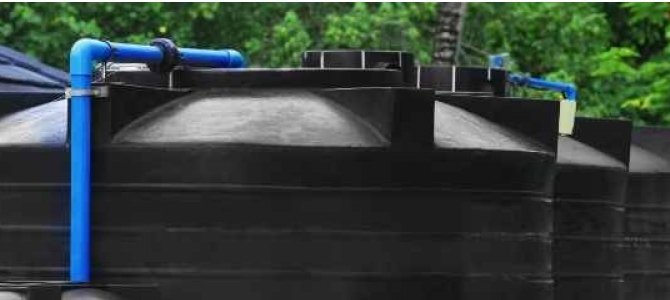 Shopping Cart
Shopping Cart
15 December 2021
Which type of water tank is best for the home?

When it comes to choosing a water tank for the home, there are a number of factors you need to take into consideration.
The first thing you need to consider is how much space you have to install your rainwater tank. This is really going to dictate the type of water tank that is going to be the best fit for your property. Another consideration that will impact the choice of material you can use is whether you are going to store your water tank above or below ground.
If you choose to go underground, your decision becomes more straightforward. Plastic water tanks can only be installed at a very shallow depth, making them impractical for most underground installations so concrete water tanks tend to be the de facto choice for any water tank installed underground.
If you are installing your tank above ground, however, you have a few different options when it comes to the best material. We have taken a close look at three of the most popular water tank materials below.
Concrete Water Tanks
Concrete water tanks and ferro-cement water tanks are generally strong and long-lasting. They are created by either a moulded (or precast) process or plastered process. Moulded tanks are usually much stronger and more durable.
They are typically constructed off-site and delivered to site full constructed.
Whilst concrete tanks are typically installed underground, you will still see a lot of above-ground concrete tanks from the days before other materials were widely available.
Concrete tanks are generally very durable, although they can develop cracks that can be problematic to fix if they can’t be properly drained.
Pros of concrete water tanks
· Can be buried underground which improves the overall aesthetics of a property
· Buried tanks can be used as retaining walls, a walkway or patio or fitted under a deck
· Helps to keep water cool due to high insulation value of concrete
· Less prone to algae due to dark conditions within the tank
· Concrete leaches lime and this can help to neutralise the water. New Zealand water is slightly acidic, and the lime raises the pH of the water
Cons of concrete water tanks
· Your site needs to be accessible to a large crane in order to install the tank – not suited to many residential properties making retrofitting difficult
· Concrete tanks are more prone to earthquake damage either under or above ground
· They are typically more expensive than plastic and steel water tanks
· It can be difficult to retrofit new outlets to the tank or carry out repairs and maintenance
Polyethylene Water Tanks (Poly Tanks)
Polyethylene (Poly) is one of the most popular materials for water tanks today. These are more commonly known as plastic tanks or poly tanks, and they are extremely versatile both in terms of the shapes they can be moulded into and the ease of installation due to the fact that they are lightweight.
All poly water tanks must be constructed from materials that are of food-grade standard and if the water is to be used for drinking, cooking, washing etc. then they must also comply with the requirements of potable water standards.
Polyethylene is the perfect material for constructing water tanks. It is non-corrosive and will not rust during their service life. They are typically made from a single piece of polyethylene with no joints or seams. This makes them less likely to leak than a concrete tank.
Poly tanks can also be recycled at the end of their service life, making them a more sustainable and even greener option than concrete tanks.
Pros of plastic water tanks
· Plastic water tanks are lightweight and easy to manoeuvre into position
· Plastic tanks are typically much cheaper than concrete tanks
· They are less prone to leaking due to no joints and seams
· They can be moulded into a range of shapes and sizes including slimline water tanks, offering greater versatility around the house
· They can be designed in a wide range of colours to match your taste
Cons of plastic water tanks
· Plastic water tanks can’t be buried so aesthetically, they need to be screened or positioned in a place that doesn’t impact the overall property aspect
· Plastic tanks can mean that your water may be a little warmer in the summer months as the insulation is not as good as concrete tanks
· Plastic water tanks are more prone to damage from fire or sharp objects
· If you have a plastic tank in high wind zones, they can require additional support and strapping depending on how full they are
Stainless Steel Water Tanks
Concrete and plastic are the two most common materials used for water tanks here in New Zealand, however, there are a couple of alternatives that you might consider depending on your requirements.
Stainless steel water tanks are made from corrugated stainless steel and they look similar to corrugated iron, just a lot shinier.
Stainless steel tanks are typically used for smaller installations and whilst they are usually more expensive than plastic tanks and even concrete tanks, they do have a number of advantages.
Pros of stainless steel water tanks
· Easy to repair and can be welded or patched with waterproof sealant
· Low corrosion, especially compared to galvanised (coated) steel
· Stainless steel is one of the most sustainable materials on earth and can be recycled time after time meaning scrap merchants will often pay you to recycle your old tank
· Stainless steel doesn’t degrade and can often provide a longer-term alternative to plastic and concrete
Cons of stainless steel water tanks
· Stainless steel is an expensive material, so these water tanks tend to cost more than plastic and concrete alternatives
· Due to cost, stainless steel water tanks are not typically used for larger installations
Summary
If you are considering installing a water tank at home, then concrete or plastic are the most likely options depending on the size of the tank and the position of your tank (above or underground). These are the two most efficient and cost-effective materials for water tanks in New Zealand, however, stainless steel is a good option for a long-term installation and for those looking for a more sustainable option.
Whilst the upfront costs of a stainless steel tank may be higher, they often last longer than plastic and concrete and are cheaper to repair, making the cost over their lifetime comparable.
If you already have a tank installed or you are thinking of installing a tank, a great addition is a water level meter that will enable you to see how much water is in your tank at any time. These are particularly useful for large tanks that are used as the main source of water for a property, however, they can be installed on a wide range of water tanks.
At Smart Water, we have engineered the most advanced tank level indicator available that now offers full cloud connectivity.
Easy to install yourself, your Smart Water tank indicator provides you with all the information you need from our app or from one of our LCD displays. Find out how much water you consume on average from your tank, accurate pressure data and estimates on when your tank will run out of water based on current usage.
Find out more about our range of products or check out our FAQs for more information.
Related Posts
· Collecting and using rainwater – a beginner’s guide
· Can you collect rainwater in NZ?
